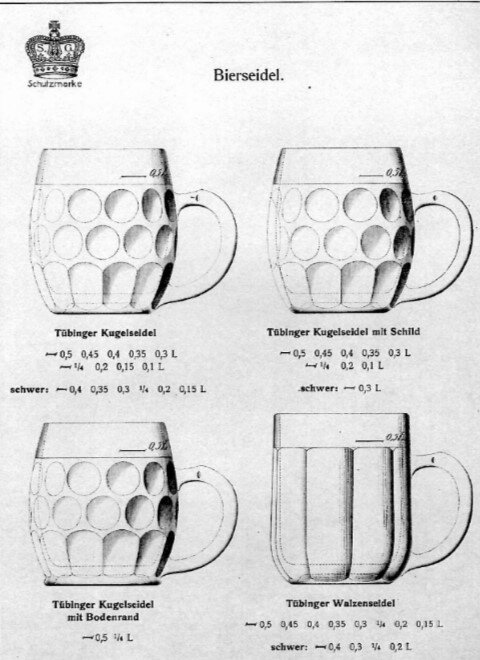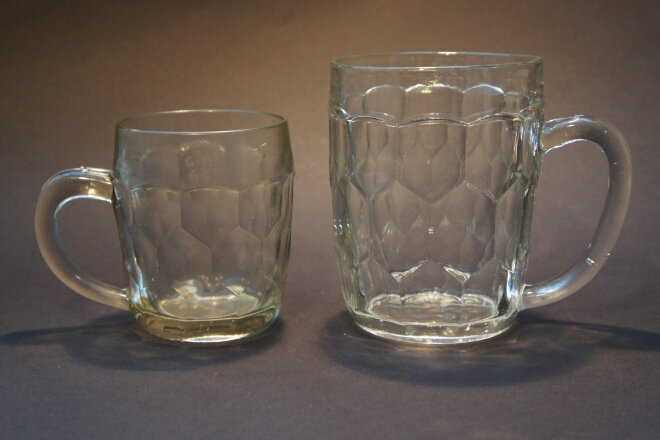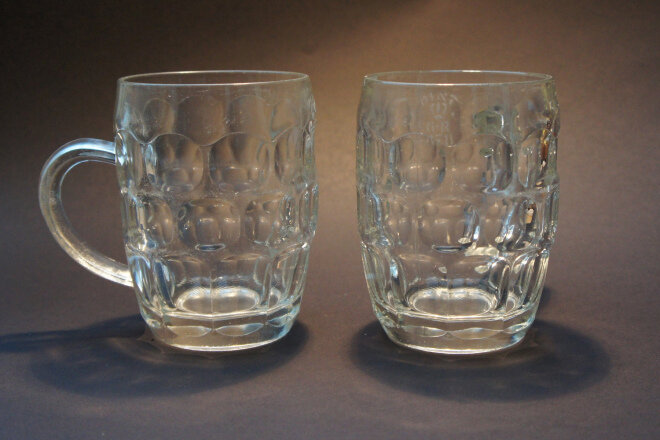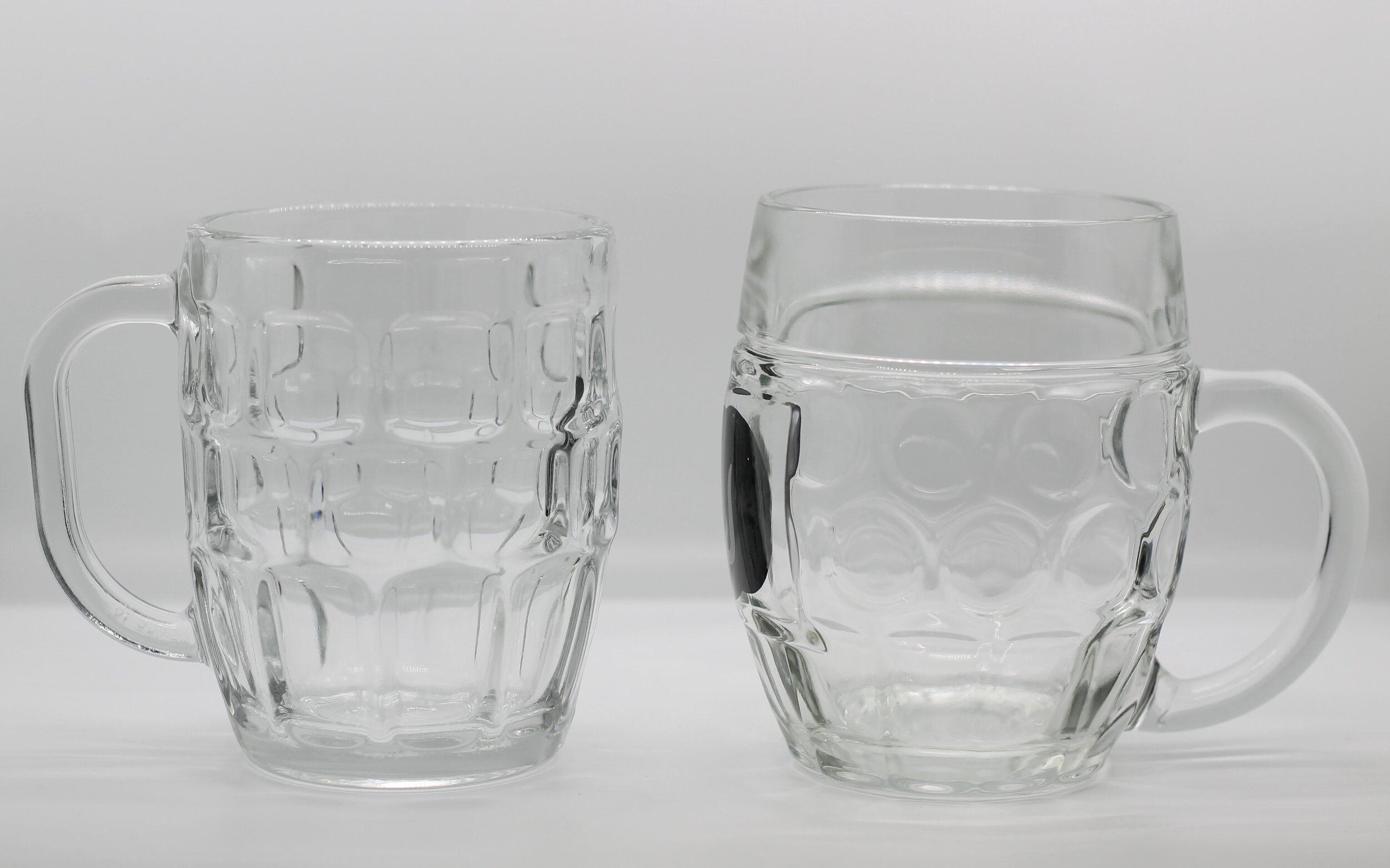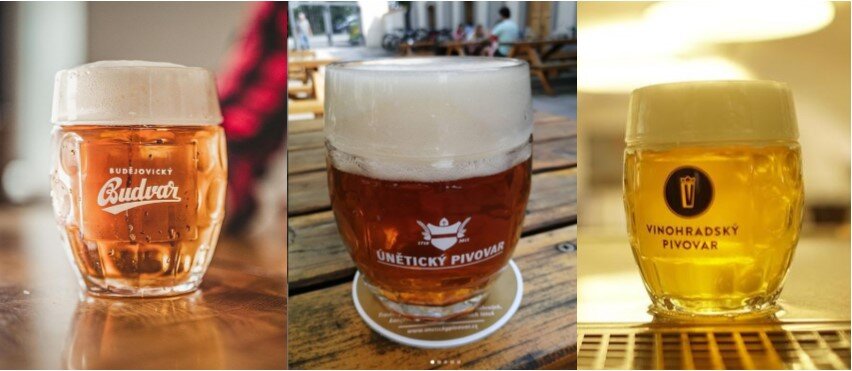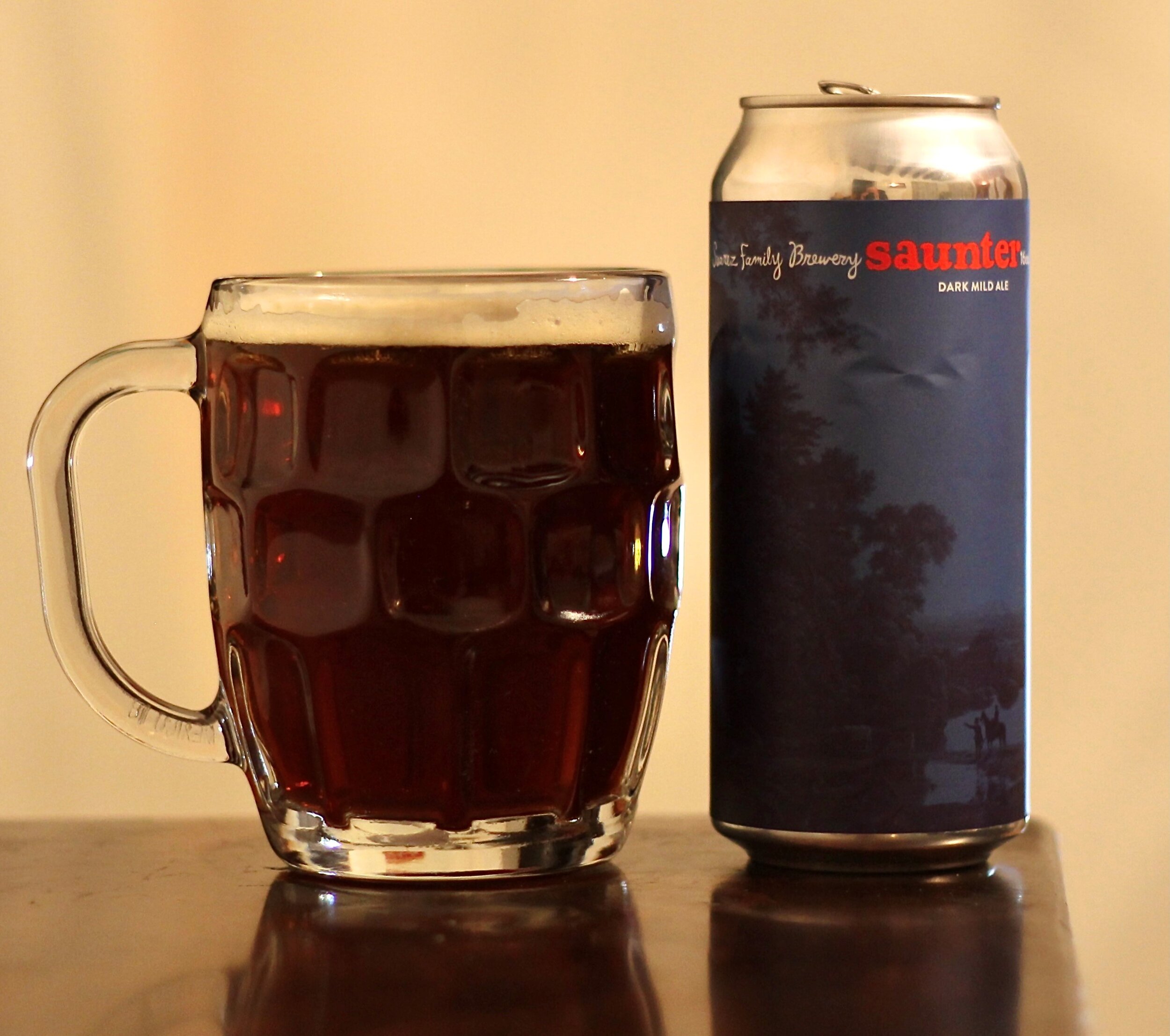Not All Dimple Mugs are Created Equal
Understanding the history and Differences Between the British Dimple and the German Tübinger
Long ago, the British dimple mug fell out of fashion in its homeland, but it is growing in popularity in the United States. With recent growth in lager production in the craft beer industry, breweries, media outlets and retailers often use a dimple when depicting lager styles of beer. However, more often than not, it’s the British dimple mug. This seems odd as the similar Tübinger Kugel glass, traditionally used in Germany and Czechia, is appropriate and readily available.
Origins
The origins of the Tübinger are connected to the Eberhard Karls University of Tübingen in the mid to late 1800s. It was here that a glass called the Tübinger Igel, a stout, handled mug, was created for the Hedgehog Academic Student Association (Akademischen Studentenverbindung Igel.) Igel means hedgehog, and the bumpy texture is designed to match accordingly.
Tübinger Igel. Source: Stein Marks
Continental beer glasses with a dimple began to appear in catalogs as early as 1878, and are identified with the word “Kugel” (more on that below). Varying styles include the dimple. Perhaps most recognizable would be the Mass (you know, that big glass mug people hoist at Oktoberfest). The Tübinger Kugel begins to appear in catalogs as early as 1906, and was sold by a number of German, Czech and Austrian firms (examples were found in other places including France and the United States).
Stölzle catalog from 1878 depicting a variety of mugs, including several with a kugel design. Source: https://www.glas-musterbuch.de/
An early Tübinger Kugel as depicted in the 1906 catalog from Krug Mundt. Source: https://www.glas-musterbuch.de/
Tübinger’s were sold by the Germany company Brockwitz for most of the early 20th century. This image is from their 1915 catalog. Source: https://www.glas-musterbuch.de/
The Tübinger is depicted in varying forms here in this 1928 catalog from Radeberg. The upper left is a standard glass. On the right it is “mit Schild”, or “with shield”, which I believe is a flat space opposite the handle for branding. On the bottom left, the glass is “mit Bodenrand”, or with bottom edge. Finally, the bottom right is a Tübinger in a different form. Source: https://www.glas-musterbuch.de/
As noted in a prior post, I have been unable to determine why the word Kugel is used, though there are a couple of possibilities. Kugel can mean bullet, ball, or sphere, and the dimples are spherical. It could also be said that the mugs have the appearance of being struck by bullets.
Tübinger Augenkanne (eye can) is also used to refer to dimpled glasses. Historically, this term may have been more prevalent in Austria.
The Tübinger predates the creation of the English dimple mug by a few decades, as, according to Martyn Cornell, the English glass was first manufactured by Ravenhead Glass in 1938. That glass quickly rose in popularity and became a standard for many pubs.
According to Cornell, the dimple “may have been inspired by the glass beer mugs with a flat hexagonal faceted exterior manufactured in Newcastle upon Tyne in the 1920s and/or early 1930s”. That’s possible. Another theory would be that someone found inspiration from the Tübinger Kugel. Or it was a hybrid of the two.
Stout shaped mugs with a hexagonal pattern that Martyn Cornell notes are from Newcastle upon Tyne, and may have been an inspiration for the dimple. Source: http://zythophile.co.uk/2015/03/28/more-notes-towards-a-history-of-the-beer-mug/
Early Ravenhead dimple mugs that Martyn Cornell suggests may be from the 1940s. Source: http://zythophile.co.uk/2015/03/28/more-notes-towards-a-history-of-the-beer-mug/
Design Analysis
The Tübinger and the British dimple are somewhat stout, handled mugs, comprised of relatively thick glass. They will generally have two to three horizontal bands of dimples. A band of flat glass is above the dimples, and a rectangular pattern, or elongated dimple, is below.
The shape of the British dimple mug is nearly straight-sided, while the Tübinger has greater curvature. It also has circular dimples, though English versions include circular and square-ish dimples with rounded corners.
The Tübinger also has a line separating the dimpled section of the mug from the flat, upper portion. On my 0.5L Sahm Tübinger from Wayfinder, this band is close to, but not matching the fill line. The mug is made in other sizes, generally from 0.25L through 0.5L. They will typically indicate the proper fill line. Historically, in England, the crown stamp was provided to indicate the design served a proper pint, but this ended in 2007. Both style glasses can now be found with CE mark for Conformité Européene (European Conformity).
The British dimple mug on the left, and the Continental Tübinger on the right.
Sensory Components
As these glasses are often confused for one another, it’s clear that there is a large amount of similarity in their design. However, there are subtle differences that impact the sensory experience when drinking from them, particularly regarding appearance and aroma.
Those that understand how important an inward curve is at the top of a glass for aroma will quickly note the difference between these two glasses. It makes the British dimple less appealing with its somewhat wide opening and lack of curvature. The Tübinger, on the other hand, with a bowl shape, has an inward curve in its upper half. It fosters better head retention and bolsters the aromatic qualities. For most styles of lager, this is important. Liz Olive, Tap Room General Manager at Notch Brewing, says “the different drinking experiences between a pub mug and a Czech mug are probably pretty subtle. But lager is subtle.”
Both glasses have handles and thick walls, and this can impact the temperature of the liquid as it is consumed. This is generally not a problem, assuming the beer is served at a proper temperature. One potential scenario where it could be an issue would be with English ales in the US, where they tend to be served too cold. Sadly, though, demand for these styles is deleteriously low.
Current Status in Europe
As noted above, the dimple mug fell out of fashion in England. While it can still be found, it is not as ubiquitous as it once was. This is despite a brief renewed interest a few years ago, according to this article in BBC News Magazine.
While it seems the Tübinger’s origins are in Germany, and still sold by German glassware companies, you are more likely to find these glasses in Czechia. But even there, it is one of many glass styles that are used. A few examples of Czech breweries that have branded Tübinger’s include Budějovický Budvar, Únětický pivovar and Vinohradský pivovar.
Branded Tübinger mugs by the Czech breweries Budějovický Budvar, Únětický pivovar and Vinohradský pivovar. Source: https://www.instagram.com/
Contemporary Manufacturers
A few contemporary companies selling Tübinger mugs include Sahm in Germany, Oberglas in Austria, and Condec in Czechia. Sahm actually has two stout dimple mugs. One is a traditional Tübinger, and the other is called Praha (Prague). The latter is not as round as the Tübinger and lacks the horizontal band.
Oberglas, who have made this glass since at least the 1930s, gives it high praise, noting in their catalog “European beer culture is virtually unimaginable without the TÜBINGER beer mug.”
Cornell noted in his above-cited post that most British dimple mugs these days are made in China by companies like Zibo Hondao Trading Co Ltd, Bengbu Longyu Glass Products (they call it a pineapple shaped glass), or the Shanghai Jingsheng Glass Co Ltd.
The British Dimple is also made by the French brand Arcoroc, and their name for the glass, “Britannia”, suggests there is an understanding that the design has a connection to England and English ales. Oddly enough, their description for the glass states it is “favoured for tasting white or Gueuze beer”.
Finally, in the United States, Libbey sells a British dimple mug. However, perhaps in an effort to generate sales, they take a very broad and erroneous approach by calling it the “Dimple Stein Beer Mug”.
In the United States
How did a dated British mug become the go-to glass for lager beer in the United States? It’s unclear, though simple ignorance could certainly be an answer. A google search for things like “dimple mug”, “beer mug”, or “German beer mug” will lead you to the Libbey glass noted above. Those not knowing the difference could easily think this glass, designed in the British tradition, is the appropriate vessel for lager.
There are lager breweries with attention to detail that properly use and sell the Tübinger. This includes Notch Brewing, Dovetail Brewery and Wayfinder Beer.
It’s incredibly hard to find breweries in the US making traditional British ales. Even harder to find one using a dimple mug. Seattle’s Machine House is the only one that comes to mind. However, there are many examples of breweries using the British dimple for their lager.
Does Any of This Matter
Yes. The distinction between these two glasses matters based on history and tradition. Aside from the subtle differences in design, they come from different places and have been vessels for different styles of beer.
Further, getting it right adds to our experience when we drink, which is important for breweries in today’s market. Ms. Olive from Notch says “I enjoy drinking a beer while watching tv or folding laundry - in a glass or straight from the can. But the EXPERIENCE, of being in the taproom, a clean, Czech mug and three fingers of dense velvety Lukr foam? There is no comparison.”
If you took out all the other experiential components, closed your eyes and tasted the same beer from each of these glasses, the experience could very well be the same. But again, there’s value in understanding the differences and the history they represent. A history that is still not well documented.
* This post was updated to eliminate a reference that suggested Pilsner Urquell does not have a Tübinger Kugel mug. They do.





